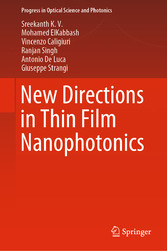Suchen und Finden
Service

New Directions in Thin Film Nanophotonics
Sreekanth K. V., Mohamed ElKabbash, Vincenzo Caligiuri, Ranjan Singh, Antonio De Luca, Giuseppe Stra
Verlag Springer-Verlag, 2019
ISBN 9789811388910 , 178 Seiten
Format PDF, OL
Kopierschutz Wasserzeichen
Geräte
Preface
6
Contents
8
Development and Applications of Metal/Dielectric Resonant Cavity-Based Thin Film Structures
12
1 Perfect Light Absorption in Thin and Ultra-Thin Films and Its Applications
13
1.1 Introduction
13
1.2 Approaches to Realize Perfect Light Absorbers
14
1.3 Lithography-Free Perfect Light Absorption in Critically Coupled, Interference Based, Thin and Ultrathin Films
16
1.4 Designer Perfect Light Absorption in Thin Film Absorbers
19
1.4.1 Designer Wavelength Range
19
1.4.2 Designer Absorption Bandwidth
21
1.4.3 Designer Profile of Optical Losses
23
1.4.4 Designer Perfect Light Absorption Angle
24
1.5 Iridescence Properties of Thin-Film Interference-Based Light Absorbers
25
1.6 Thermally Induced Perfect Light Absorption in Low Reflectance Metals
27
1.7 Applications
31
1.7.1 Structural Colors Using Thin-Film Light Absorbers
31
1.7.2 Hydrogen Gas Sensing Using Thin-Film Light Absorbers
33
References
35
2 Realization of Point-of-Darkness and Extreme Phase Singularity in Nanophotonic Cavities
38
2.1 Topological Darkness
38
2.2 Lithography-Free Nanophotonic Cavities
39
2.3 Singular Phase at the Point-of-Darkness
41
2.4 Phase-Sensitive Biosensing
44
2.5 Microfluidics Integrated Cavities
47
2.6 Real-Time Sensing of Small Biomolecules
49
References
52
3 Phase Change Material-Based Nanophotonic Cavities for Reconfigurable Photonic Device Applications
54
3.1 Phase Change Material-Tuned Photonics
54
3.2 Tunable Color Filters Based on Multilayer Stacks
56
3.3 Tunable Perfect Absorption
58
3.4 Tunable Singular Phase at the Point-of-Darkness
60
3.5 Enhanced and Tunable Goos-Hanchen Shift at the Point-of-Darkness
63
References
66
4 Sub-wavelength Nanopatterning Using Thin Metal Films
68
4.1 Laser Interference Lithography
68
4.2 Evanescent Wave Interference Lithography
69
4.3 Plasmonic Lithography
71
4.4 Theoretical Analysis of Surface Plasmon Interference
72
4.5 Numerical Analysis of Surface Plasmon Interference
78
4.6 Nanopatterning Based on Multiple Beams Surface Plasmon Interference
80
References
86
Development and Applications of Multilayered Hyperbolic Metamaterials
88
5 Dielectric Singularities in Hyperbolic Metamaterials
89
5.1 Introduction
89
5.2 Effective Medium Theory and HMMs Dispersion Relation
90
5.3 Design of the Epsilon-Near-Zero-and-Pole Condition
94
5.4 Far-Field Analysis and Scattering Parameters of Ag/ITO ENZP HMM
97
5.5 Light Propagation at the ENZP Wavelength and Supercollimation Effect
99
5.6 ENZP Perfect Lens
101
5.7 Three Materials ENZP HMMs
103
References
108
6 Resonant Gain Singularities in Hyperbolic Metamaterials
110
6.1 Resonant Gain Epsilon-Near-Zero and Pole Condition
110
6.2 Design of the Gain Blend
112
6.2.1 Step 1—Selecting a High Refractive Index Dielectric
112
6.2.2 Step 2—Selecting a Dye with Emission Peaked at 426 nm
113
6.2.3 Step 3—Calculating the Value of ?d'' for Which ? '' Shows a Pole at 426 nm
113
6.2.4 Step 4 and 5—Calculation of the Concentration overlineN0 of Dye Molecules and of the “Gain Blend” Effective Permittivity
114
6.2.5 Step 6—Verifying the Presence of the “Resonant Gain Singularity” in ? '' at the ENZP Wavelength
116
6.3 Supercollimation and Light Amplification in the RG-HMM
116
6.4 Self-Amplified Perfect Lens (APL)
119
References
121
7 Metal/Photoemissive-Blend Hyperbolic Metamaterials for Controlling the Topological Transition
123
7.1 Introduction
123
7.2 Design, Fabrication and Characterization of the Thermo-Responsive Blend
124
7.3 Design, Fabrication and Characterization of the HMM Embedding the Thermo-Responsive Blend
128
7.4 Thermal Tunability of the Optical and Photophysical Response of the HMM
130
References
134
8 Guided Modes of Hyperbolic Metamaterial and Their Applications
135
8.1 Guided Modes of Hyperbolic Metamaterials
135
8.2 Excitation of Guided Modes of HMM
136
8.2.1 Using Grating Coupling Technique
136
8.2.2 Using Prism Coupling Technique
142
8.3 Applications of Grating-Coupled HMMs
145
8.3.1 Ultrasensitive Plasmonic Biosensing
145
8.3.2 Spontaneous Emission Enhancement
152
8.3.3 Multiband, Broad- and Narrow-Band Perfect Absorption and Absorption-Based Plasmonic Sensors
157
References
162
9 Graphene and Topological Insulator-Based Active THz Hyperbolic Metamaterials
165
9.1 Introduction
165
9.2 Graphene-Based Hyperbolic Metamaterials
166
9.3 Van der Waals Superlattice-Based Hyperbolic Metamaterials
168
9.4 Negative Refraction in THz Hyperbolic Metamaterials
169
9.4.1 Negative Refraction in Graphene-Based HMMs
170
9.4.2 Negative Refraction in Topological Insulator-Based HMMs
171
9.5 Excitation of BBP Modes of Graphene-Based HMMs
173
9.6 Active Hyperbolic Metamaterials Based on Topological Insulator and Phase Change Material
175
References
177
Shop


